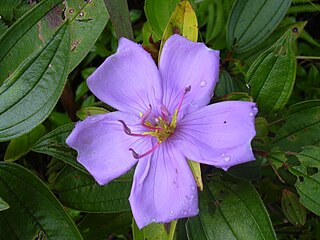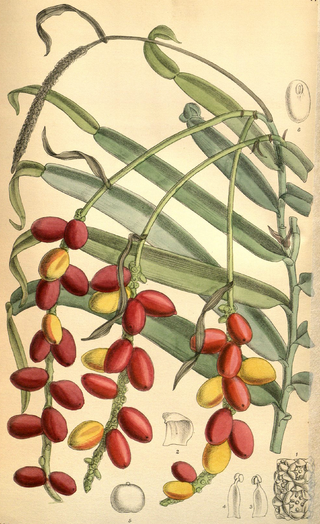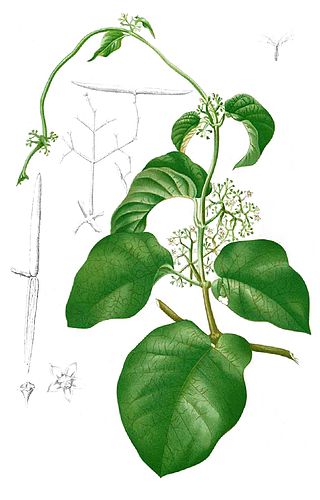
Olea is a genus of flowering plants in the family Oleaceae. It includes 12 species native to warm temperate and tropical regions of the Middle East, southern Europe, Africa, southern Asia, and Australasia. They are evergreen trees and shrubs, with small, opposite, entire leaves. The fruit is a drupe. Leaves of Olea contain trichosclereids.

Blumeodendron is a genus of dioecious trees of the family Euphorbiaceae first described as a genus in 1873. It is widespread across much of Southeast Asia and Papuasia.

Kayea is a plant genus in the family Calophyllaceae. Its species range from Bangladesh and the eastern Himalayas to Sri Lanka, Indochina, Peninsular Malaysia, Borneo, Sumatra, the Philippines, New Guinea, and Queensland.

Melastoma is a genus in the family Melastomataceae. It has over 100 species distributed around Southeast Asia, India, north to Japan, south to Australia and the Pacific Islands. The number of species should probably be reduced according to some sources. Many species have been planted around the world for the aesthetic value of their bright purple flowers.

Dracula is a 1931 Spanish-language American horror film directed by George Melford. The film is based on both the novel Dracula by Bram Stoker and the play Dracula by Hamilton Deane and John L. Balderston. The film is about Renfield, who travels to Translyvania to visit Conde Drácula. He is drugged by the Count and becomes his minion. The two travel to England, where Drácula begins to seduce Lucía Weston as she becomes his first victim. This leads Professor Van Helsing to investigate, who confirms that Drácula is a vampire.

Pothos is a genus of flowering plants in the family Araceae. It is native to China, the Indian Subcontinent, Australia, New Guinea, Southeast Asia, and various islands of the Pacific and Indian Oceans.

Kibatalia is a genus of trees and shrubs in the family Apocynaceae, tribe Malouetieae, first described as a genus in 1826. It was initially called Hasseltia, but this turned out to be an illegitimate homonym. So Kibatalia was chosen as a replacement name. Kibatalia is native to China and Southeast Asia.
- Kibatalia arborea(Blume) G.Don – Thailand, Philippines, W Malaysia, Borneo, Sumatra, Java, Sulawesi
- Kibatalia blancoi(Rolfe ex Stapf) Merr. – Philippines
- Kibatalia borneensis(Stapf) Merr. – Sarawak
- Kibatalia elmeriWoodson – Luzon
- Kibatalia gitingensis(Elmer) Woodson – Philippines
- Kibatalia laurifolia(Ridl.) Woodson – Vietnam, Cambodia, Thailand, W Malaysia
- Kibatalia longifoliaMerr. – Mindanao
- Kibatalia macgregori(Elmer) Woodson – Sibuyan
- Kibatalia macrophylla(Pierre ex Hua) Woodson – Yunnan, Indochina
- Kibatalia maingayi(Hook.f.) Woodson – Thailand, W Malaysia, Borneo, Sumatra, Mindanao
- Kibatalia merrillianaWoodson – Leyte, Samar
- Kibatalia puberulaMerr. – Samar in Philippines
- Kibatalia stenopetalaMerr. – Luzon, Dinagat, Mindanao
- Kibatalia villosaRudjiman – W Malaysia, Borneo
- Kibatalia wigmani(Koord.) Merr. – Sulawesi
- Kibatalia africana(Benth.) Merr. = Funtumia africana(Benth.) Stapf
- Kibatalia elastica(Preuss) Merr. = Funtumia elastica(Preuss) Stapf
- Kibatalia latifolia(Stapf) Merr. = Funtumia africana(Benth.) Stapf
- Kibatalia scheffieri(K.Schum.) Merr. = Funtumia africana(Benth.) Stapf
- Kibatalia zenkeri(K.Schum.) Merr. = Funtumia africana(Benth.) Stapf

Xanthostemon is a genus of plants in the myrtle family Myrtaceae, first described in 1857 by the German–born Australian botanist Ferdinand von Mueller. The genus is distributed across Malesia, Papuasia and northern Australia. The genera Pleurocalyptus and Purpureostemon from New Caledonia are morphologically close to Xanthostemon.

Planchonia is a genus of trees and shrubs in the family Lecythidaceae first described as a genus in 1851. It is native to Southeast Asia, Papuasia, and Australia.
- Planchonia brevistipitataKuswata – Sabah
- Planchonia careya (F.Muell.) R.Knuth – cockatoo apple, cocky apple or billygoat plum – New Guinea, Queensland, Northern Territory, Western Australia
- Planchonia grandisRidl. – Peninsular Malaysia, Borneo, Sumatra
- Planchonia papuanaR.Knuth – New Guinea, Solomon Islands, Aru
- Planchonia rupestris R.L.Barrett & M.D.Barrett – Western Australia
- Planchonia spectabilisMerr. – Luzon, Mindanao
- Planchonia timorensis Blume – Timor
- Planchonia valida(Blume) Blume – Andaman & Nicobar, Peninsular Malaysia, Borneo, Sumatra, Lesser Sunda Islands, Sulawesi, Java
Antherostele is a genus of flowering plants in the family Rubiaceae. It is endemic to the Philippines.

Diploknema is a genus of plant in the Sapotaceae described as a genus in 1884.

Chisocheton is a genus of trees in the family Meliaceae. The genus name comes from the Greek schizos and chiton meaning "split tunic", referring to the lobed staminal tube of C. patens. Their range is from India and tropical China, throughout Malesia and south to New South Wales and Vanuatu.
Vanoverberghia is a genus of plants in the Zingiberaceae, named after Morice Vanoverbergh (1885–1982), a Catholic missionary priest who lived in the Philippines and was also an anthropologist and a linguist.

Callicarpa (beautyberry) is a genus of shrubs and small trees in the family Lamiaceae. They are native to east and southeast Asia, Australia, Madagascar, south-eastern North America and South America.

Disporopsis is a genus of plants in the Asparagaceae. It is native to China, Indochina and the Philippines.

Streptocaulon is a genus of plants in the family Apocynaceae, first described as a genus in 1834. It is native to India, China and Southeast Asia.
Estrellados is a 1930 American pre-Code comedy film directed by Salvador de Alberich and Edward Sedgwick, and written by Salvador de Alberich, Paul Dickey and Richard Schayer. The film stars Buster Keaton, Raquel Torres, Don Alvarado, María Calvo, Juan de Homs and Carlos Villarías.

The Nueva Ecija Rice Vanguards are a Filipino professional basketball team based in the province of Nueva Ecija. The team competes in the Maharlika Pilipinas Basketball League (MPBL) as a member of the league's North Division. They are one of five teams based in the Central Luzon region and play their home games at Nueva Ecija Coliseum in Palayan.

Alocasia heterophylla is a plant in the family Araceae. It is endemic to the islands of Luzon, Mindanao, and Polillo in the Philippines.
Omphalea malayana is a species of flowering plant in the family Euphorbiaceae, native to Peninsular Malaysia, Borneo (Sarawak) and the Philippines (Luzon). It was first described by Elmer Drew Merrill in 1916.
















